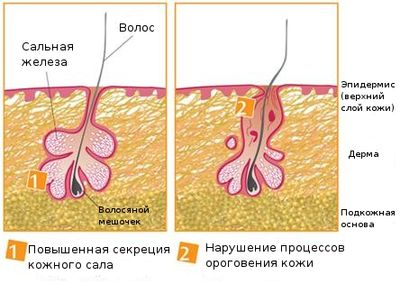Glycerin contained in the secretion of the sebaceous glands plays an important role in maintaining normal skin moisture by providing its barrier function. In addition, sebum forms a lipid layer on the surface of the epidermis, which prevents excessive transepidermal moisture loss.
However, hypersecretion of the sebaceous glands leads to excessive greasiness of the skin, which is often accompanied by acne. Oily problematic skin is quite common, so on estet-portal.com read about the main mechanisms of sebum formation, as well as about effective methods of dealing with increased secretion of sebum.
Oily problematic skin: main complaints
Patients, especially teenagers, often complain of oily skin problems. If greasiness is expressed moderately or strongly — then, most often, they are worried about the need to wash their face several times a day. At the same time, the skin becomes greasy again after a few hours. The second complaint is the increase in oiliness of the skin when applying sunscreen.
Problem oily skin requires mandatory cosmetic treatment, since this condition almost always affects the feeling of inner comfort and attractiveness of a person.
The clinical problem of oily skin is due to hypersecretion of lipids, which leads to the appearance of a greasy sheen on the skin. Often the condition is complicated by hyperplasia of the sebaceous glands, which is characterized by the formation of papules 0.5-1.5 mm in the T-zone.
You may also be interested in: What should be the care of oily skin
Factors that provoke an increase in oily skin
It is widely believed that the level of androgens plays the main role in increasing the activity of the sebaceous glands, however, research data turn out to be very contradictory. The activity of the sebaceous glands does not directly depend on the level of testosterone, since the secretion of sebum in men and women does not have pronounced differences, despite a significant difference in the level of the hormone.

A low-active androgen dehydroepiandrosterone sulfate (DEAS), which is converted into testosterone by the enzyme 5-alpha reductase type 1, can play a certain role in the appearance of acne. Unfortunately, the treatment of acne with inhibitors of this enzyme does not have a pronounced clinical effect.
Stress is known to significantly increase the level of free fatty acids on the surface of the skin.
This is due to the fact that the sebaceous glands have receptors for corticoliberin, a stress hormone that directly enhances lipogenesis and accelerates the conversion of DEAS to testosterone in sebocytes.
Sebum production has also been confirmed to be genetically dependent.
Read the latest articles in Telegram!
Cosmetic methods for treating oily problematic skin
Most cosmetics for oily skin contain ingredients such as talc, which do not suppress the secretion of sebum, but absorb it on their surface.
Anti-androgen drugs such as ketoconazole and spironolactone have a short-term sebum-reducing effect in women (2-3 months).
Today, complex preparations containing erythromycin and zinc are often used to treat hyperactive sebaceous glands.
It should be noted that topical retinoids do not reduce sebum secretion, but only improve its excretion. However, oral administration of isotretinoin can reduce the secretion of sebum, due to the fact that the drug has an effect on the life cycle of the cell, as well as on its apoptosis.
Cosmetic treatments such as glycolic acid peels and microdermabrasion do not cause glandular depletion. Therefore, although these methods are suitable for post-acne therapy, they are completely ineffective for reducing oily skin.
Thus, when working with patients with oily problematic skin, the doctor should remember that not all popular therapies are really effective, and without diet and lifestyle changes, even the best cosmetics and drugs may be useless.
Read also: Problem skin — gentle care







Add a comment